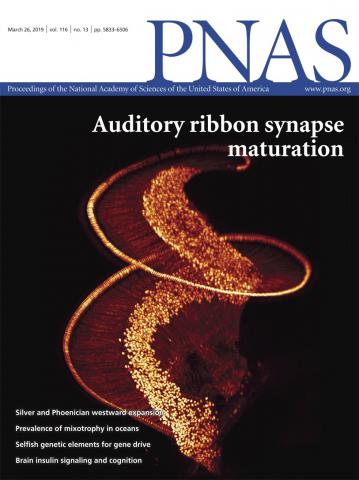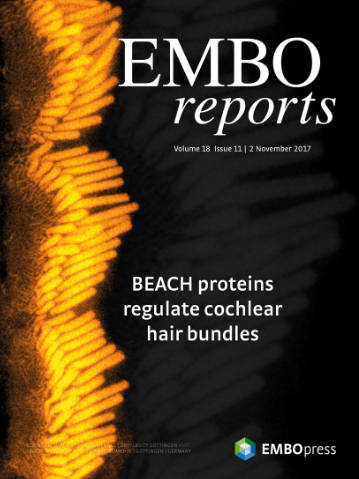Auditory Neuroscience
Group/personal information:
AG: Auditory Neuroscience
Group leader: Dr. phil. Christian Vogl
Location: Schöpfstr. 41/1st floor, office 154
Email: Christian.vogl@i-med.ac.at
Phone: +43 (0) 512 9003 70805
ORCID: https://orcid.org/0000-0003-4432-2733
Google Scholar: https://scholar.google.com/citations?user=_eYW1tYAAAAJ&hl=de&oi=ao
ResearchGate: https://www.researchgate.net/profile/Christian-Vogl-2
Scientific interests:
Ribbon synapses of auditory inner hair cells (IHCs) transmit acoustic information with exquisite temporal precision. Here, synaptic sound encoding – i.e., the translation of a physical sound waves into neural code – is achieved by ultrafast and tightly regulated presynaptic exocytosis of glutamate-filled synaptic vesicles onto postsynaptic spiral ganglion neurons (SGNs). In this system, it is commonly believed that presynaptic ribbons play a major role in orchestrating synaptic release (e.g., by clustering presynaptic voltage-gated Ca2+ channels and other components of the release machinery) and rapid vesicular replenishment to ensure a constant supply of vesicles and hence prevents synaptic fatigue.
Within the past decade, a range of molecular scaffolds and key regulators of these presynaptic complexes could be identified and have deepened our understanding of this unconventional synapse. Moreover, a large body of work has investigated mechanisms of synaptogenesis within the organ of Corti, providing insights into neuronal pathfinding and synapse formation in the auditory periphery. However, fundamental aspects of these processes – such as ribbon precursor trafficking to the active zone, ribbon anchoring and active zone structural plasticity – remain largely elusive.
With the advent of super-resolution microscopy and the capability of performing long-term fluorescent fiber tracing and particle tracking experiments in living cells, many of these open questions can now be adequately addressed. Therefore, our group employs a comprehensive methodological approach that combines fluorescent labelling of synaptic components in living IHCs with immunohistochemical analyses to track developing ribbon synapses in real time and subsequently identify the involved cell biological processes.
Current research topics:
- Developmental assembly of auditory ribbon synapses
- Modes of activity-dependent structural plasticity at auditory ribbon synapses
- Identification and characterization of novel deafness genes
- Cochlear anatomy and neuronal connectivity
- Synaptic regulation of neurotransmitter release at auditory ribbon synapses
Main methodologies:
- Advanced microscopy techniques (confocal, super-resolution STED, 2-photon microscopy, chemical clearing)
- Live-cell imaging (single particle tracking, neuronal fiber tracing, Ca2+ imaging, etc.)
- Patch clamp electrophysiology
- Primary and secondary tissue culture (organotypic, cell lines)
- Optogenetics
Current lab members:
PhD students:
Roos Anouk Voorn
Victoria Christine Halim
Jan Frederik Ahrend
Technical support:
Theresa Martha
Funding sources:
Deutsche Forschungsgemeinschaft (DFG)
Fonds zur Förderung Wissenschaftlicher Forschung (FWF)
Elisabeth und Helmut Uhl Foundation
Collaborators:
Prof. Dr. Jörg Enderlein (Georg-August University, Göttingen, Germany)
Prof. Dr. Seth Grant (University of Edinburgh, UK)
Prof. Dr. Itaru Himachi (Kyoto University, Japan)
Prof. Dr. Manfred Kilimann (Max-Planck Institute for Natural Sciences, Göttingen, Germany)
Dr. Katie Kindt (NIH/NIDCD Bethesda, USA)
Prof. Dr. Shigeki Kiyonaka (Nagoya University, Japan)
Prof. Dr. Tobias Moser (University Medical Center Göttingen, Germany)
Prof. Dr. Dominik Oliver (Philipps-University Marburg, Germany)
Prof. Dr. Carolin Wichmann (University Medical Center Göttingen, Germany)
Prof. Dr. Fred Wolf (Max-Planck Institute for Dynamics and Self-organization, Göttingen, Germany)
Selected publications:
1.) Vogl C#, Neef J, Wichmann C# (2022) Methods for multiscale structural and functional analysis of the mammalian cochlea. Mol Cell Neurosci. 2022 Mar 11;103720. doi: 10.1016/j.mcn.2022.103720. (Review)
2.) Rankovic V#,*, Vogl C#,*, Dörje NM, Bahader I, Duque-Afonso CJ, Thirumalai A, Weber T, Kusch K, Strenzke N, Moser T* (2021): Overloaded adeno-associated virus as a novel gene therapeutic tool for otoferlin-related deafness. Front. Mol. Neurosci. Jan 7;13:600051. doi: 10.3389/fnmol.2020.600051. eCollection 2020.
3.) Voorn RA & Vogl C# (2020) Molecular assembly and structural plasticity of sensory ribbon synapses – a presynaptic perspective. Int.J.Mol.Sci. 2020,21,8758; doi:10.3390/ijms21228758. (Review)
4.) Kleinlogel S*, Vogl C*, Jeschke M*, Neef J & Moser T (2020) Emerging approaches for restoration of hearing and vision. Physiol Rev 2020 Oct 1;100(4):1467-1525. doi: 10.1152/physrev.00035.2019. (Review)
5.) Michanski S, Smaluch K, Steyer AM, Chakrabarti R, Setz C, Oestreicher D, Fischer C, Möbius W, Moser T, Vogl C#, Wichmann C# (2019): Mapping developmental maturation of inner hair cell ribbon synapses in the apical mouse cochlea. Proc Natl Acad Sci U S A. 2019 Mar 26;116(13):6415-6424. doi: 10.1073/pnas
6.) Kroll J*, Jaime Tobón LM*, Vogl C*, Neef J, Kondratiuk I, König M, Strenzke N, Wichmann C, Milosevic I, Moser T (2019): Endophilin-A regulates presynaptic Ca2+ influx and synaptic vesicle recycling in auditory hair cells. EMBO J 2019 Mar 1;38(5). pii: e100116. doi: 10.15252/embj.2018100116.
7.) Vogl C#, Butola T, Haag N, Hausrat TJ, Leitner MG, Moutschen M, Lefebvre PP, Speckmann C, Garrett L, Becker L, Fuchs H, Hrabe de Angelis M, Nietzsche S, Kessels MM, Oliver D, Kneussel M, Kilimann MW, Strenzke N# (2017): The BEACH protein LRBA is Required for Hair Bundle Maintenance in Cochlear Hair Cells and for Hearing. EMBO Rep. 2017 Sep 11. pii: e201643689. doi: 10.15252/embr.201643689
8.) Vogl C*, Panou I*, Yamanbaeva G*, Wichmann C*, Mangosing S*, Vilardi F*, Indzhykulian AA*, Pangršič T*, Santarelli R, Rodriguez-Ballesteros M, Weber T, Jung S, Wu X, Wojcik SM, Kwan KY, del Castillo I, Schwappach B, Strenzke N, Corey DP, Lin SY, Moser T (2016): Tryptophan-rich basic protein (WRB) mediates insertion of the tail-anchored protein otoferlin and is required for hair cell exocytosis and hearing. EMBO J. 2016 Jul 25. pii: e201593565. doi 10.15252/embj.201593565
9.) Vogl C#, Cooper B, Neef J, Strenzke N, Reisinger E, Reim K, Brose N, Rhee JS, Moser T*, Wichmann C# (2015): Unconventional molecular regulation of synaptic vesicle replenishment in cochlear inner hair cells. J Cell Sci. 2015 Feb 15;128(4):638-44. doi: 10.1242/jcs.162099
10.) Vogl C, Mochida S, Wolff C, Whalley BJ, Stephens GJ (2012): The SV2A Ligand Levetiracetam Inhibits Presynaptic Ca2+ Channels Via an Intracellular Pathway. Mol Pharmacol. 2012 Aug;82(2):199-208.
*equal contribution; #shared correspondence
Journal Covers:

PNAS 116 (13) 2019

EMBO Reports (2017)18:2015-2029



